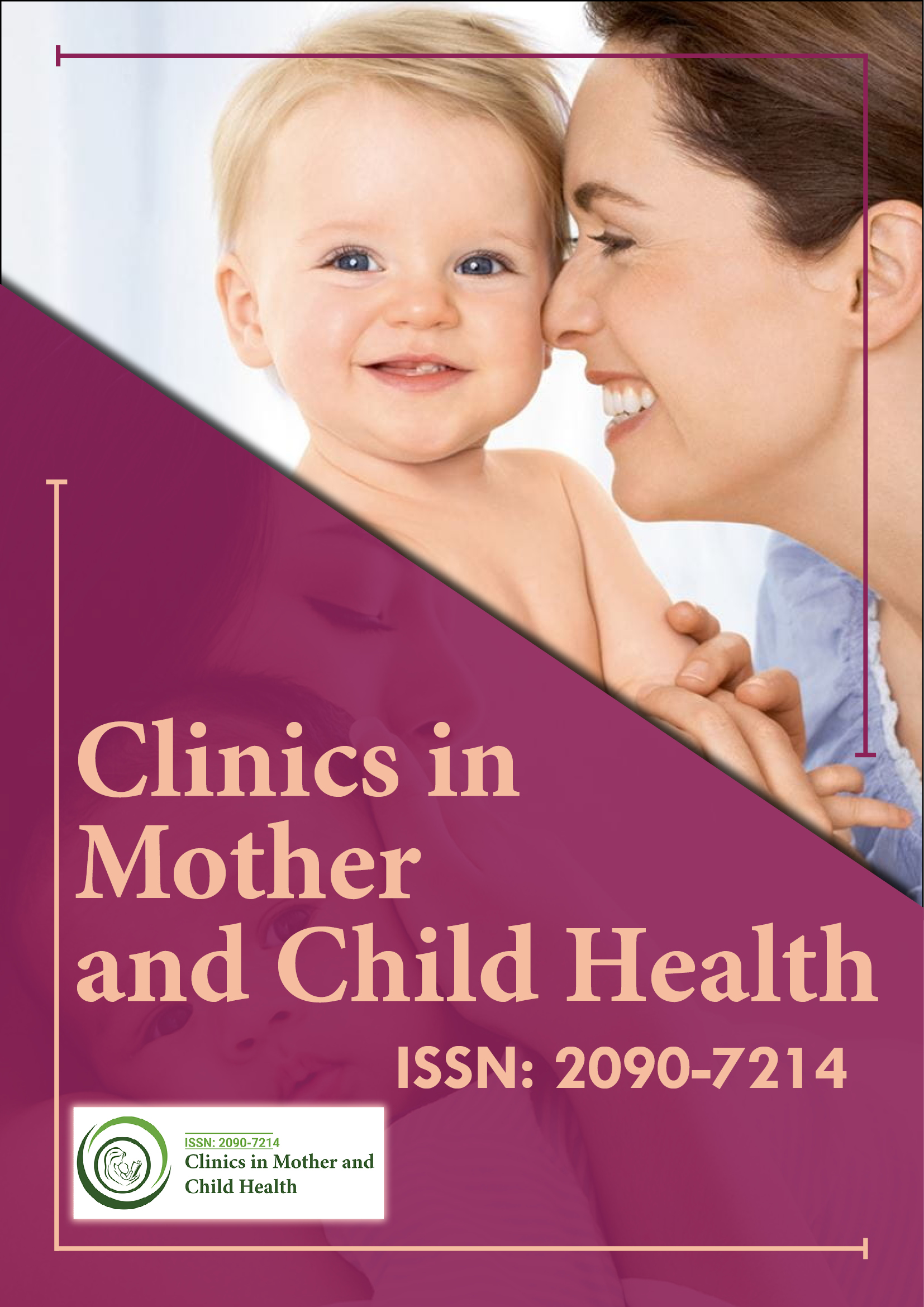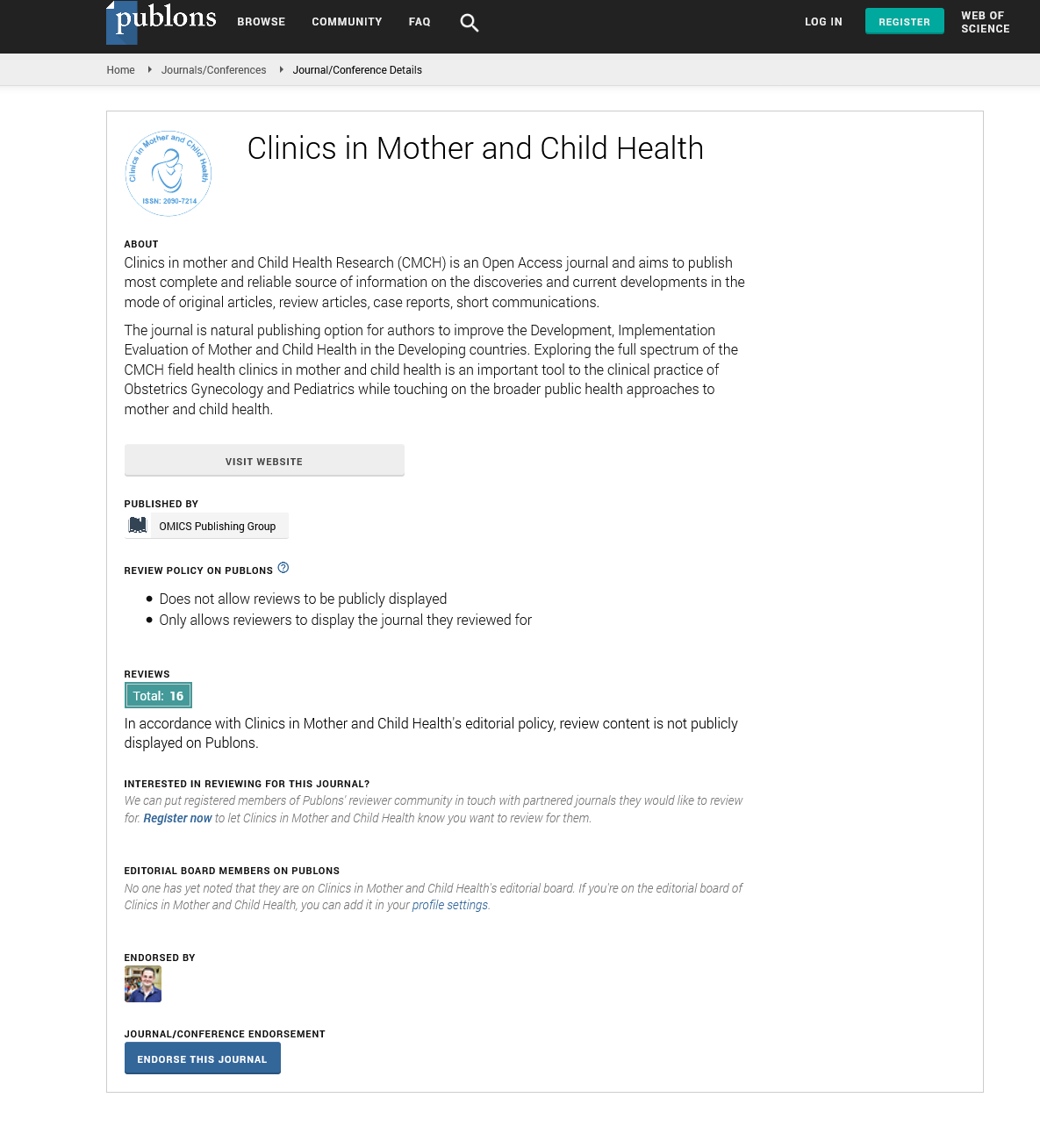Indexed In
- Genamics JournalSeek
- RefSeek
- Hamdard University
- EBSCO A-Z
- Publons
- Geneva Foundation for Medical Education and Research
- Euro Pub
- Google Scholar
Useful Links
Share This Page
Journal Flyer

Open Access Journals
- Agri and Aquaculture
- Biochemistry
- Bioinformatics & Systems Biology
- Business & Management
- Chemistry
- Clinical Sciences
- Engineering
- Food & Nutrition
- General Science
- Genetics & Molecular Biology
- Immunology & Microbiology
- Medical Sciences
- Neuroscience & Psychology
- Nursing & Health Care
- Pharmaceutical Sciences
Short Communication - (2025) Volume 22, Issue 3
Effects of Maternal Anemia on Infant Growth and Development
Elizabeta Murillo*Received: 28-Feb-2025, Manuscript No. CMCH-25-29053; Editor assigned: 03-Mar-2025, Pre QC No. CMCH-25-29053; Reviewed: 17-Mar-2025, QC No. CMCH-25-29053; Revised: 22-Mar-2025, Manuscript No. CMCH-25-29053; Published: 31-Mar-2025, DOI: 10.35248/2090-7214.25.22.515
Description
Maternal anemia, particularly during pregnancy, remains a significant public health concern globally, especially in low- and middle-income countries. Defined as a hemoglobin concentration of less than 11 g/dL during pregnancy, anemia is most commonly caused by iron deficiency, though it can also result from nutritional deficits, infections, chronic diseases, and parasitic infestations. According to the World Health Organization (WHO), an estimated 40% of pregnant women worldwide suffer from anemia, which not only affects maternal health but also has profound implications on fetal growth and postnatal development [1]. This study investigates the effects of maternal anemia on infant growth and developmental outcomes during the critical early years of life. The intrauterine environment plays a pivotal role in determining a child’s health trajectory. During pregnancy, iron and other essential nutrients are transferred from mother to fetus, supporting the development of key organs and systems. Anemia in pregnant women, especially when moderate to severe, can compromise oxygen delivery to the fetus due to reduced hemoglobin levels. This inadequate oxygenation can impair fetal growth, resulting in Intrauterine Growth Restriction (IUGR), Low Birth Weight (LBW), and preterm delivery—all of which are known risk factors for poor physical and cognitive development in infancy and childhood [2].
This research study focuses on evaluating the associations between maternal anemia and infant outcomes such as birth weight, length, head circumference, growth velocity, and cognitive development during the first year of life. A prospective cohort design was adopted, involving pregnant women diagnosed with anemia during their antenatal checkups and followed through delivery and up to the first 12 months postpartum. Infants born to these women were compared with those born to non-anemic mothers across various growth and developmental parameters [3]. Data collection included clinical assessments, anthropometric measurements, developmental screening tools, and structured caregiver interviews. Preliminary findings from the study reveal a consistent pattern: infants born to anemic mothers had lower mean birth weights and lengths compared to those born to non-anemic mothers. The incidence of preterm births and Small-for-Gestational-Age (SGA) infants was also higher in the anemic group. Furthermore, during follow-up visits at 6 and 12 months, these infants demonstrated slower weight gain, reduced linear growth, and smaller head circumferences, which are indicative of compromised growth and potentially delayed neurodevelopment [4].
In terms of cognitive and motor development, assessments using standardized tools such as the Ages and Stages Questionnaire (ASQ) showed that infants of anemic mothers were more likely to have delays in fine motor, gross motor, and problem-solving skills by their first birthday. These developmental concerns are believed to be linked not only to the intrauterine nutrient and oxygen deprivation but also to ongoing challenges in infant feeding and caregiving practices [5]. Maternal anemia may contribute to reduced energy levels, fatigue, and postpartum depression, which can hinder optimal breastfeeding, stimulation, and responsive parenting—all of which are vital for a child’s early development. Socioeconomic and environmental factors were also analyzed to contextualize the findings. Maternal education, household income, dietary diversity, and access to antenatal care were strongly associated with both the incidence of anemia and the observed infant outcomes. Women from lower-income households with limited nutritional knowledge and food insecurity were more prone to iron-deficiency anemia, and their children were correspondingly more vulnerable to stunting and developmental delays [6].
The study highlights the urgent need for strengthening maternal nutrition programs, especially iron and folic acid supplementation and dietary counseling during antenatal visits. Early identification and management of anemia in pregnancy must become a public health priority. Community-based awareness campaigns, fortified foods, and routine hemoglobin screening can aid in preventing and mitigating the effects of anemia on maternal and child health [7]. Moreover, integrating maternal mental health and infant development support into postnatal care services can enhance outcomes for both mother and child. In conclusion, maternal anemia has a measurable and adverse impact on infant growth and developmental trajectories. This study adds to the growing body of evidence that underscores the intergenerational effects of maternal health and nutrition. Addressing maternal anemia is not only essential for improving birth outcomes but also for ensuring that children reach their full developmental potential [8]. A multisectoral approach involving health systems, nutrition programs, education, and social protection is vital to break the cycle of poor maternal health and suboptimal child development. As countries work toward achieving Sustainable Development Goals related to health (SDG 3), nutrition (SDG 2), and education (SDG 4), interventions targeting maternal anemia must be prioritized. Investing in maternal well-being is a foundational step toward building healthier, more productive future generations [9-10].
References
- Abu-Ouf NM, Jan MM. The impact of maternal iron deficiency and iron deficiency anemia on child’s health. Saudi medical journal. 2015;36(2):146.
[Crossref] [Google Scholar] [PubMed]
- Neef V, Choorapoikayil S, Hof L, Meybohm P, Zacharowski K. Current concepts in postpartum anemia management. Curr Opin Anaesthesiol. 2024;37(3):234-8.
[Crossref] [Google Scholar] [PubMed]
- Zhang Y, Jin L, Liu JM, Ye R, Ren A. Maternal hemoglobin concentration during gestation and risk of anemia in infancy: Secondary analysis of a randomized controlled trial. J Pediatr. 2016;175:106-10.
[Crossref] [Google Scholar] [PubMed]
- Marques RF, Taddei JA, Lopez FA, Braga JA. Breastfeeding exclusively and iron deficiency anemia during the first 6 months of age. Rev Assoc Med Bras. 2014;60:18-22.
[Crossref] [Google Scholar] [PubMed]
- Calvo EB, Galindo AC, Aspres NB. Iron status in exclusively breast-fed infants. Pediatr. 1992;90(3):375-9.
[Crossref] [Google Scholar] [PubMed]
- Buck S, Rolnick K, Nwaba AA, Eickhoff J, Mezu-Nnabue K, Esenwah E, et al. Longer Breastfeeding Associated with Childhood Anemia in Rural Southâ?Eastern Nigeria. "Int J Pediatr. 2019;2019(1):9457981.
[Crossref] [Google Scholar] [PubMed]
- Zhao B, Sun M, Wu T, Li J, Shi H, Wei Y. The association between maternal anemia and neonatal anemia: A systematic review and meta-analysis. BMC pregnancy and childbirth. 2024;24(1):677.
- Sangkhae V, Nemeth E. Placental iron transport: The mechanism and regulatory circuits. Free Radic Biol Med 2019;133:254-61.
- Widness JA. Pathophysiology of anemia during the neonatal period, including anemia of prematurity. Neoreviews. 2008;9(11):e520-5.
- Chaparro CM, Suchdev PS. Anemia epidemiology, pathophysiology, and etiology in lowâ?and middleâ?income countries. Ann NY Acad Sci. 2019;1450(1):15-31.
Citation: Murillo E (2025). Effects of Maternal Anemia on Infant Growth and Development. Clinics Mother Child Health.22:515.
Copyright: © 2025 Murillo E. This is an open-access article distributed under the terms of the Creative Commons Attribution License, which permits unrestricted use, distribution and reproduction in any medium, provided the original author and source are credited.

